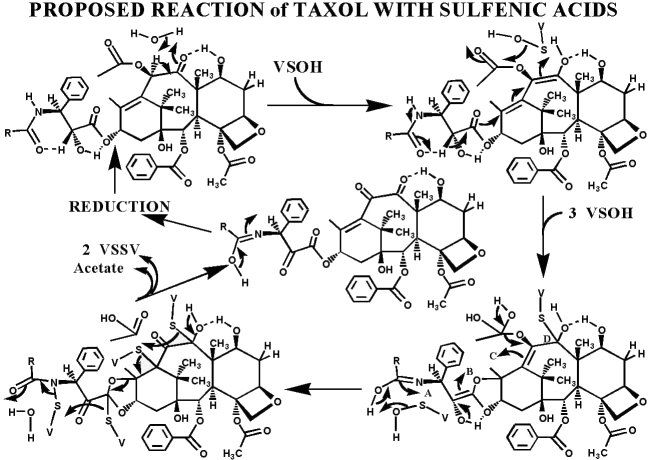
POSSIBLE SYNERGISM OF TAXOL AND VITALETHINE
Vitalethine is thought to be most therapeutic in only its disulfide, thiol, or sulfenic acid forms. To some extent these compounds are interconvertible in the body, since the disulfide form can be reduced to the thiol form and then oxidized to a sulfenic acid form by its monooxygenase enzyme receptor.
If too much of the sulfenic acid is produced, however, it is though that it can polymerize into a tetramer, especially when exposed to too much UV irradiation, say from "getting too much sun". This tetramer is thought to be capable of blocking up to four of the monooxygenase receptors, thereby blocking the regulation of proliferation. Through this mechanism, too much sun can translate into increased risks of too much cell division, and neoplasia (wrinkles) or cancer.
While beneficial in growing more skin to heal that painful sunburn, proliferation clearly is contraindicated when one has cancer. This is where taxol may become important. Taxol has chemistry within its structure that probably reacts with excess sulfenic acid molecules. This same reaction is very dangerous in aflatoxins, since, when irreversible, it can cause depletion of the cancer-preventing sulfenic acids. However, with taxol and vitamin C there is additional chemistry within their structures that allows them to reversibly release the vitaletheine adduct as either the therapeutic disulfide (VSSV) or thiol (VSH), respectively, as the following diagram for taxol illustrates:

Four molecules of sulfenic acid are all it takes to form the tetramer and taxol has the capacity to bind up all four molecules. Since vitalethine has been shown to be effective at as little as 3 attograms/ml in cell culture, or at concentrations of about 1 molecule per cell or less, a single molecule of taxol is capable of completely inhibiting the division of cells caused by the tetramer of vitaletheine (vitaletheine V4). While it is interesting to speculate that using low doses of taxol might be just as effective as high doses in fighting cancer, one has to realize that the monooxygenase is catalytically recycling any reduced vitaletheine modulators back into their sulfenic acid forms, so the trick is to get just enough taxol in there to prevent proliferation without getting enough in to reductively jeopardize the therapeutic levels of vitaletheine's sulfenic acid.
GO TO:
| Home | Overview | People | Journal | Nutrition |
| Environment |
|
WWW Links | Outline | e-mail us |